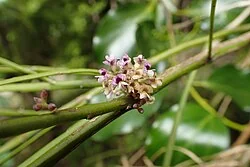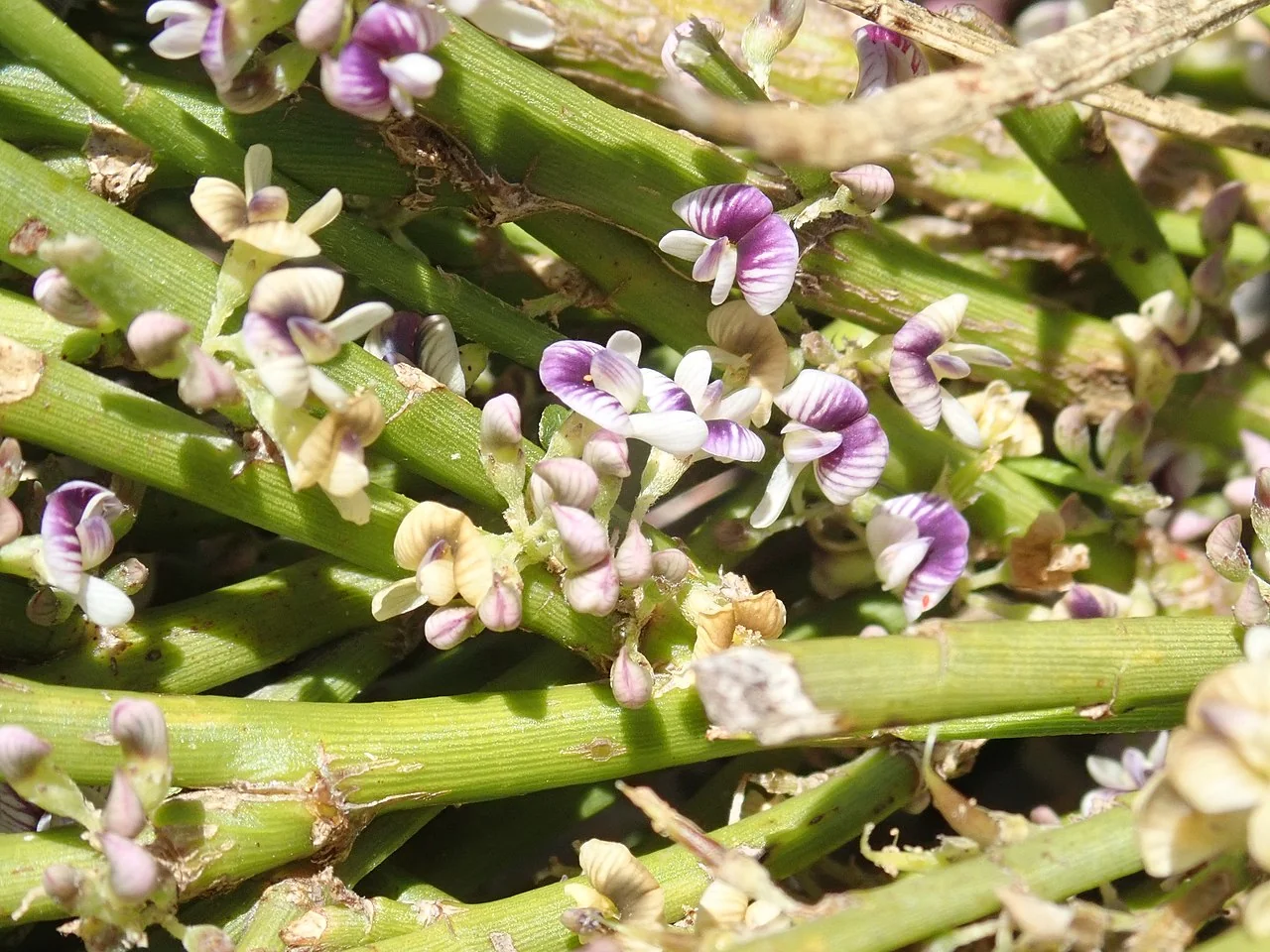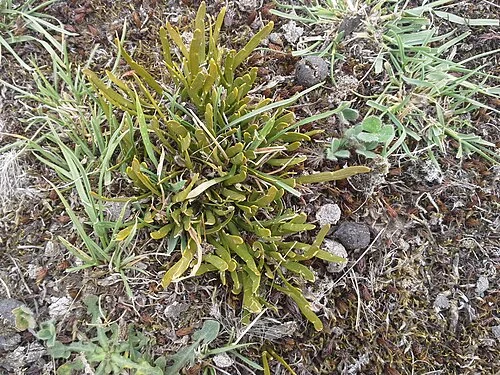
Native Broom
Carmichaelia australis
Plant Introduction
Native Broom ( Carmichaelia australis ) is one of New Zealand's most distinctive shrubs , characterized by its unique leafless green branches that perform photosynthesis. This striking member of the pea family creates an architectural presence in the landscape with its erect, ribbed stems that can reach up to 5 meters in height. Endemic to New Zealand and found throughout both islands, this drought-tolerant species thrives in open, free-draining habitats from coastal areas to montane zones. Its ability to fix nitrogen enriches surrounding soils, while its purple-pink flowers provide nectar for native insects. As a pioneer species, Native Broom plays a crucial role in revegetation projects and provides habitat structure for various wildlife in New Zealand's drylands and forest margins.

Plant Description
Carmichaelia australis , commonly known as New Zealand common broom or mākaka, is an endemic shrub belonging to the Fabaceae family. It is found throughout New Zealand, particularly in lowland and mid-montane sites, often in shrublands and forest margins.
This hardy, fast-growing plant typically ranges from a small to large shrub, growing between 1-2 meters, though it can reach 2-8 meters in height and 2-5 meters in spread. A distinguishing feature of Carmichaelia australis is its flattened to round photosynthetic stems (cladodes), which are green, yellow-green, or brown-green and take in sunlight, largely replacing the need for leaves. While seedlings and young plants may have small leaves with three to five leaflets, these are typically absent in adult plants.
From spring through summer, it produces small (5-6 mm) white flowers, often with purple veins and sometimes purple centers. These flowers are attractive to insects and bees. The fruit appears from November to May as small, dry, oblong pods, 6.5-15 mm long, which contain 1-5 seeds. The seeds are typically yellow, orange, or red, sometimes with black dots, and are distributed when the seedpod bursts.
Carmichaelia australis prefers full sunlight and well-drained soil, tolerating dry, windy, and cold conditions down to -7 °C. It is drought-tolerant once established but cannot withstand waterlogging for extended periods. As a member of the Fabaceae family, it is a nitrogen-fixing species, forming a symbiotic relationship with Rhizobia bacteria in its root nodules, which enhances soil fertility.
Quick Facts
| Scientific Name | Carmichaelia Australis |
|---|---|
| Height | 2-5 m |
| Spread | 2-8 m |
| Water Needs | Low once established |
| Light | Full sun to light shade |
| Frost Tolerance | High |
| Salt Tolerance | Moderate |
| Growth Rate | Moderate |
| Lifespan | Long-lived shrub |
Climate Best Suited to
Native Broom ( Carmichaelia australis ) is highly adaptable, thriving across a wide range of temperate, lowland to montane climates throughout New Zealand. It demonstrates excellent tolerance to dry, windy, and cold conditions, making it suitable for diverse environments from coastal areas to higher altitudes. It prefers free-draining soils and sunny exposures, though it benefits from some shelter in very cold sites. Its resilience makes it a valuable plant for various regions across Aotearoa.
| Whangārei | Ideal |
| Auckland | Ideal |
| Hamilton | Suitable |
| Rotorua | Suitable |
| Tauranga | Ideal |
| Gisborne | Ideal |
| New Plymouth | Ideal |
| Whanganui | Ideal |
| Palmerston North | Suitable |
| Napier | Ideal |
| Wellington | Ideal |
| Nelson | Ideal |
| Christchurch | Suitable |
| Dunedin | Suitable |
| Invercargill | Suitable |
| City | Climate Suitability |
|---|
Habitat
Natural Distribution
Carmichaelia australis , also known as New Zealand common broom, is a shrub endemic to New Zealand, found across both the North and South Islands, though not in the southern South Island. It exhibits a broad ecological niche, thriving in a variety of environments from coastal to inland sites, and from lowland to montane areas. Its natural habitat includes river terraces, stony flats, stream banks, colluvium inclines, rock outcrops, talus, fan toe slopes, tussock grasslands, edges and margins of dense bush and forest, and around swamps. It prefers free-draining, low to moderately fertile soils, including stony, sandy, or gravelly sites, and avoids prolonged waterlogging and heavy clays.
Plant Conservation
Native Broom ( Carmichaelia australis ) is currently classified as "Not Threatened" nationally in New Zealand, reflecting its widespread distribution and adaptability across various habitats. However, it is listed as "At Risk - Declining" in several regions, such as Auckland, due to habitat loss and browsing pressure from introduced animals.
Conservation efforts focus on protecting its natural habitats, controlling invasive species, and promoting its use in restoration plantings. Its ability to fix nitrogen makes it valuable for improving soil fertility in degraded areas.
Growing Requirements
Requires full sun and excellent drainage. Suits gravelly, sandy, or stony soils and will tolerate poor fertility and dry periods once established. Avoid waterlogged sites and heavy, compacted clays. Young plants appreciate shelter from strong, salty winds; mature plants are very tolerant. Do not over-fertilise: excess nutrients encourage soft, leggy growth.
Planting Guide
Best Planting Practices
Prepare a wide, free-draining planting hole; on heavy soils, build a raised mound with coarse gravel and sharp sand. Set the root ball slightly high so the crown stays dry, and backfill firmly. Water to settle then mulch lightly with inert mineral mulch (grit or stone). Space plants 1-1.5 m apart for screens. Protect from rabbits/hares and stock while establishing; stake only if windy exposure dictates.
Ecological Role
Environmental Benefits
Carmichaelia australis plays a vital ecological role in New Zealand's dryland and open shrubland ecosystems. As a nitrogen-fixing legume, it significantly contributes to soil fertility, making it a crucial pioneer species for stabilizing dry slopes and alluvial soils. Its unique branch architecture provides essential habitat and shelter for various native fauna, contributing to biodiversity and supporting complex food webs. The plant's resilience and ability to thrive in harsh conditions make it an important component of ecological restoration projects.
Uses and Significance
Carmichaelia australis , also known as New Zealand common broom or mākaka, is an endemic shrub with significant ecological and cultural value in New Zealand.
Ecological Significance and Uses:
- Nitrogen Fixation: As a member of the Fabaceae (legume) family, Carmichaelia australis forms a symbiotic relationship with Rhizobia bacteria in its root nodules. This allows it to fix atmospheric nitrogen, enriching soil fertility and making it valuable in restoration plantings, especially in open and disturbed sites.
- Habitat and Food Source: The plant provides shelter for small invertebrates and its flowers attract native insects, including honeybees, for nectar. It also serves as a host plant for specialized native insects, such as the newly discovered aphid species Megaoura stufkensi , and various mites, beetles, moths, and butterflies. The oblong seed pods, maturing between November and May, contain distinctive orange, red, or green seeds that support diverse wildlife.
- Ecological Adaptation: Carmichaelia australis demonstrates exceptional ecological versatility, thriving in various habitats across New Zealand, from coastal environments to montane areas, including river terraces, stream banks, rock outcrops, tussock grasslands, and forest margins. It enhances habitat structure and provides seasonal resources for birds and invertebrates.
Garden Uses:
- Carmichaelia australis is an excellent plant for rock gardens, borders, and coastal areas. Its leafless stems and pea-like flowers make it a charming addition to any landscape. It is a hardy and fast-growing plant that prefers full sun and well-drained soil but tolerates dry, windy, and cold conditions. Its unique structural form and open foliage are often highlighted in garden designs.
Cultural Significance:
- Within Mātauranga Māori, native plants like Carmichaelia australis are important for sustaining the health of the ngahere (forest) and local ecosystems, reflecting an integrated approach where people are part of the ecosystem.
Cultural Significance
Traditional Uses and Values
Native Broom ( Carmichaelia australis ) was used by Māori for various purposes. The tough, flexible stems were used for weaving and construction, and the plant also had medicinal uses in rongoā (traditional Māori medicine).
Landscaping Uses
Garden Design Applications
Carmichaelia australis is an excellent choice for creating resilient, low-water landscaping schemes. Its unique form and drought tolerance make it ideal for combining with other hardy native plants such as hebes, olearia, and various tussocks. This creates a naturalistic and sustainable garden that requires minimal irrigation and maintenance, while providing year-round visual interest and ecological benefits.
Seasonal Care Calendar
Spring
Spring is an ideal time for new growth and flowering for Carmichaelia australis . Ensure adequate moisture for newly planted specimens. A light application of a balanced, slow-release native plant fertilizer can support vigorous growth and flowering. Monitor for any early signs of pests or diseases.
Summer
During summer, Carmichaelia australis continues its active growth and flowering. Established plants are drought-tolerant, but young plants may require occasional deep watering during prolonged dry periods. Avoid overwatering. Light pruning can be done after the main flush of flowers to maintain shape, but avoid heavy cuts.
Autumn
Autumn is a good time for planting new specimens, allowing them to establish before winter. Reduce watering as temperatures cool and natural rainfall increases. The plant may develop seed pods, which can be collected for propagation. Minimal maintenance is required for established plants.
Winter
Carmichaelia australis is highly frost-tolerant and provides year-round interest with its distinctive leafless stems. Minimal care is needed during winter. Ensure good drainage to prevent root issues in wet conditions. Protect young plants from severe frosts in very cold regions.
When to Prune and How Much
Pruning Details
Native Broom generally requires minimal pruning. Light tip-pruning can be done after flowering to shape the plant and encourage denser growth. It is crucial to avoid making hard cuts into old, bare wood, as Carmichaelia australis can be slow to reshoot from older stems.
How to Grow Native Broom
Site Selection and Soil
Prefers full sun for best growth and flowering, but can tolerate light shade. Thrives in free-draining, low to moderately fertile soils. It does well in stony, sandy, or gravelly sites and can adapt to various soil conditions. Avoid prolonged waterlogging. It is wind-hardy and suitable for coastal and inland dry sites.
Planting
Plant in autumn or spring in a weed-free, free-draining spot. Set the plant at pot depth, then firm the soil and water to settle. Mulch lightly, keeping the stems clear, and provide temporary rabbit protection if needed. For group planting or restoration projects, space plants 80 cm to 1 meter apart.
Watering
Carmichaelia australis is drought-tolerant once established. Water moderately during the first one to two years after planting. Thereafter, it has low water needs, and occasional watering is sufficient. Avoid overwatering to prevent root rot.
Care and Maintenance
Requires minimal maintenance once established. It generally does not require fertilizer, but a light application in spring may enhance flowering. Pruning is rarely needed, but plants can be lightly trimmed after flowering to maintain a tidy form. Trim back by a third, focusing on dead or overcrowded wood to maintain airflow and shape. It is a nitrogen-fixing legume, which means it improves soil fertility.
Propagation from Seed
Easily grown from seed. Seeds benefit from scarification or boiling water treatment. For cuttings, take semi-hardwood cuttings from healthy plants, make a clean cut below a node, and remove lower leaves. Rooting hormone can enhance development. Plant cuttings in well-draining soil with good moisture retention and protect them from direct sun until roots establish.
Propagation from Cuttings
For cuttings, take semi-hardwood cuttings from healthy plants, make a clean cut below a node, and remove lower leaves. Rooting hormone can enhance development. Plant cuttings in well-draining soil with good moisture retention and protect them from direct sun until roots establish.
Pests and Diseases
Common Problems and Solutions
Carmichaelia australis is generally a robust and healthy plant, rarely suffering from significant pests or diseases when grown in suitable conditions. However, young plants (juveniles) should be protected from browsing animals like rabbits and hares, which can cause significant damage. Ensuring excellent drainage is crucial to prevent root issues, as the plant is susceptible to root rot in waterlogged soils. Good air circulation also helps to prevent fungal problems. Overall, with proper care, this native broom remains relatively trouble-free.
Bonus Tip
Expert Growing Advice
Native Broom ( Carmichaelia australis ) is a nitrogen-fixing legume, meaning it enriches the soil by converting atmospheric nitrogen into a usable form. This makes it an excellent pioneer species for improving soil fertility in degraded areas.







